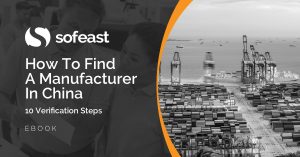Here are some interesting or useful articles that I found recently.
some interesting or useful articles that I found recently.
Quality Management Systems in China Explained
Fredrik Grönkvist asked me the following questions about certifications to the ISO 9001 standard (and to other QMS standards):
- What is a Quality Management System and why is it relevant to importers?
- Is certification mandatory, or is it common that Chinese manufacturers implement a Quality Management System without obtaining the paper?
- How can you determine if the supplier is applying a comprehensive Quality Management System if they are not certified?
- How common is it that suppliers do obtain a QMS certificate without actually implementing it?
- Is QMS certification more important in some industries, and less important in others?
- What other signals do you recommend small to medium volume importers look at?
7 reasons why it is hard to start small when buying from China [Infographic]
Purchasing small quantities in China is not easy. Learn why in this infographic based on an article written by Adam Gilbourne. Very true.
China Wages Policy Backfires as Costs Prompt Sock-City Blues
The town of Zhuji is a cluster of sock manufacturers. Most of the work is done by machines, and yet factory owners complain of the rising cost of labor. They don’t understand that they need to change their “one worker tends to one machine” mentality, as well as their way of doing business.
How Do Small Textile Factories Survive in Expensive China?
Neale O’Connor, an Australian professor and researcher who studies the Chinese manufacturing sector, visited a few textile factories and took notes about the managers’ grievances.
China Manufacturing: How To Hang On To YOUR Molds
Surprisingly, I still see many purchasers use agreements that can’t be enforced in China, and many others who blindly trust their suppliers. These are big mistakes. In this article, Dan Harris reminds us of legal strategies to discourage Chinese suppliers from appropriating the tooling paid for by importers.
The Decline of the Buying Office
This article describes the changing role of the trading companies and the in-house buying offices when it comes to serving large textile importers. The latest trends include the increase in functions of the buying office and the higher risk of making a tax-free profit in Hong Kong.
China’s patent applications are nearly double those of the US or Japan. Does it mean that Chinese companies are developing a lot of new technologies and new products? Not exactly, as The Economist demonstrates.
Are you wondering how to find a manufacturer in China who is well-suited to your needs and can also deliver on their promises?
Sofeast has developed 10 verification steps to help you find the right manufacturer. They’re shared in this FREE eBook: “How To Find A Manufacturer In China: 10 Verification Steps.”
It covers:
- Background checks
- Manufacturing capabilities
- Quality system auditing
- Engineering resources
- Pricing, negotiation, & contracts
- …and much, much more
Just hit the button below to get your copy:

